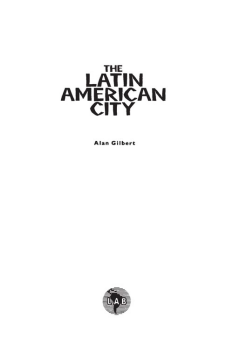
Additional Information
Book Details
Abstract
Since the 19S0s, Latin America has been transformed from a rural to an urban society. The region now contains some of the world's biggest cities, headed by Mexico City with its 20 million inhabitants. In all but five Latin American countries, more people now live in towns and cities than in the countryside. This mass movement from country to city has put enormous strain on the infrastructure and services of cities such as Bogota and Caracas. Conditions continue to worsen as governments cut back social spending in their structural adjustment programmes. The Latin American City looks at the region's urban explosion from the perspective of the poor. It asks why people are attracted to the city and examines the underlying problem of rural poverty which fuels the exodus. It explores the options open to those arriving in the city and the strategies used in order to acquire land and build a home. Highlighting the role of the informal sector in urban survival, it also explains how popular organisation and protest can result in improved living standards for the poor.
Table of Contents
| Section Title | Page | Action | Price |
|---|---|---|---|
| Title Page | iii | ||
| Copyright Page | iv | ||
| Table of Contents | v | ||
| 1: The Urban Landscape | 1 | ||
| Santafé de Bogotá | 2 | ||
| Caracas | 7 | ||
| Guadalajara | 11 | ||
| Rio de Janeiro | 14 | ||
| La Paz | 18 | ||
| Notes | 22 | ||
| Further Reading | 22 | ||
| 2: The Growth of the Latin American City | 23 | ||
| Back in Time | 23 | ||
| From a Rural to an Urban Society | 26 | ||
| The Shape of the City | 29 | ||
| Economic Development and Urban Growth | 31 | ||
| Urban Primacy and the Growth of Megacities | 34 | ||
| Notes | 38 | ||
| Further Reading | 38 | ||
| 3: The Move to the City | 39 | ||
| The Rural Scene | 41 | ||
| The Nature of Migration | 44 | ||
| To which Cities do Migrants Move? | 47 | ||
| Changes in the Migration Process | 49 | ||
| The Impact of Economic Recession | 51 | ||
| The Effects of Migration on the City | 52 | ||
| Return Migration | 54 | ||
| Notes | 56 | ||
| Further Reading | 56 | ||
| 4: The World of Work | 57 | ||
| How do People Earn a Living? | 57 | ||
| The Theory of over-urbanisation | 59 | ||
| Unemployment | 61 | ||
| The Informal Sector | 65 | ||
| What is the Role of the Informal Sector? | 67 | ||
| The Informal Sector: Expansion or Decline? | 71 | ||
| The Situation of Women | 74 | ||
| Child Labour | 75 | ||
| Notes | 78 | ||
| Further Reading | 78 | ||
| 5: Housing Strategies | 79 | ||
| The City Before 1950 | 79 | ||
| The Rise of Self-help Housing | 80 | ||
| Acquiring Land | 84 | ||
| Building a Home | 85 | ||
| The Struggle for Services | 90 | ||
| Owners, Tenants and Sharers | 93 | ||
| Self-help Housing: Solution or Exploitation? | 96 | ||
| Notes | 102 | ||
| Further Reading | 102 | ||
| 6: Urban Management | 103 | ||
| Services and Infrastructure | 104 | ||
| The Administration of Service Delivery | 108 | ||
| Transport | 113 | ||
| Pollution and the Environment | 119 | ||
| Disasters | 123 | ||
| Notes | 125 | ||
| Further Reading | 125 | ||
| 7: Urban Protest | 127 | ||
| Why is there so Little Protest? | 128 | ||
| (1) Community Attitudes | 128 | ||
| (2) Clientelism | 132 | ||
| (3) Leadership and Co-optation | 132 | ||
| (4) Repression | 134 | ||
| Urban Social Movements | 136 | ||
| After the Mexico City Earthquake | 137 | ||
| The Rise of new Social Movements | 142 | ||
| Protest during the Recession | 145 | ||
| Notes | 154 | ||
| Further Reading | 154 | ||
| 8: The Future of the City | 155 | ||
| National Economic Growth | 155 | ||
| The Changing International Division of Labour | 156 | ||
| Demographic Pressure | 160 | ||
| Urban Employment | 162 | ||
| Governance | 163 | ||
| Repaying the Social Debt | 168 | ||
| Income Inequality | 169 | ||
| Further Reading | 170 | ||
| Bibliography | 171 | ||
| Index | 185 |
